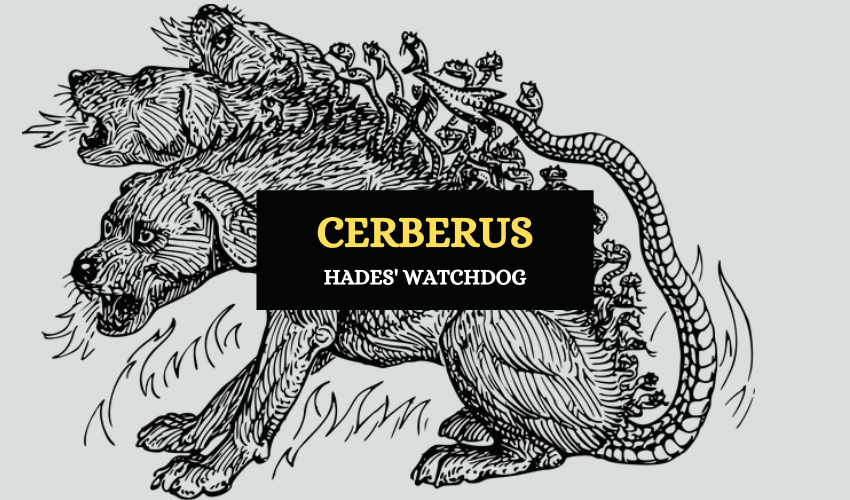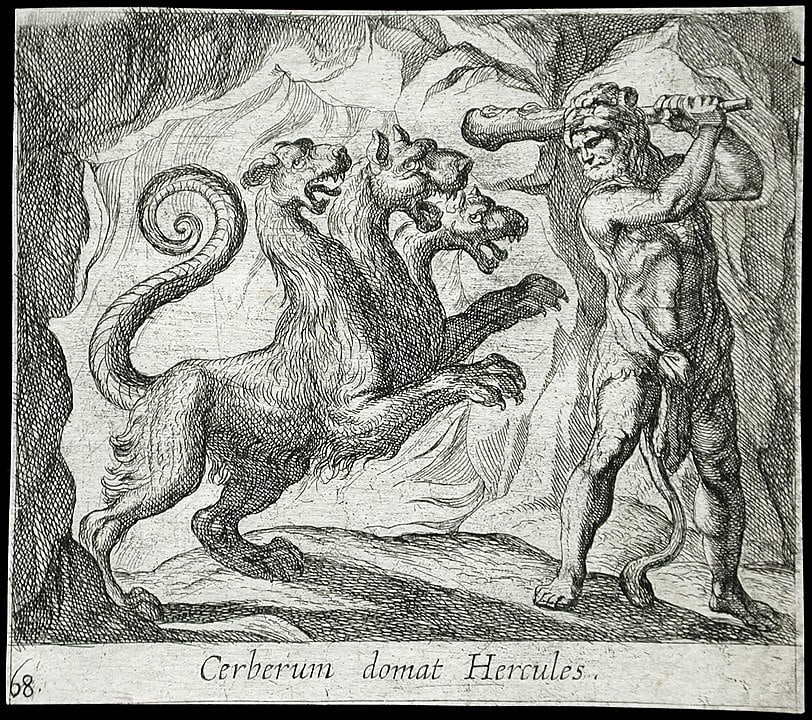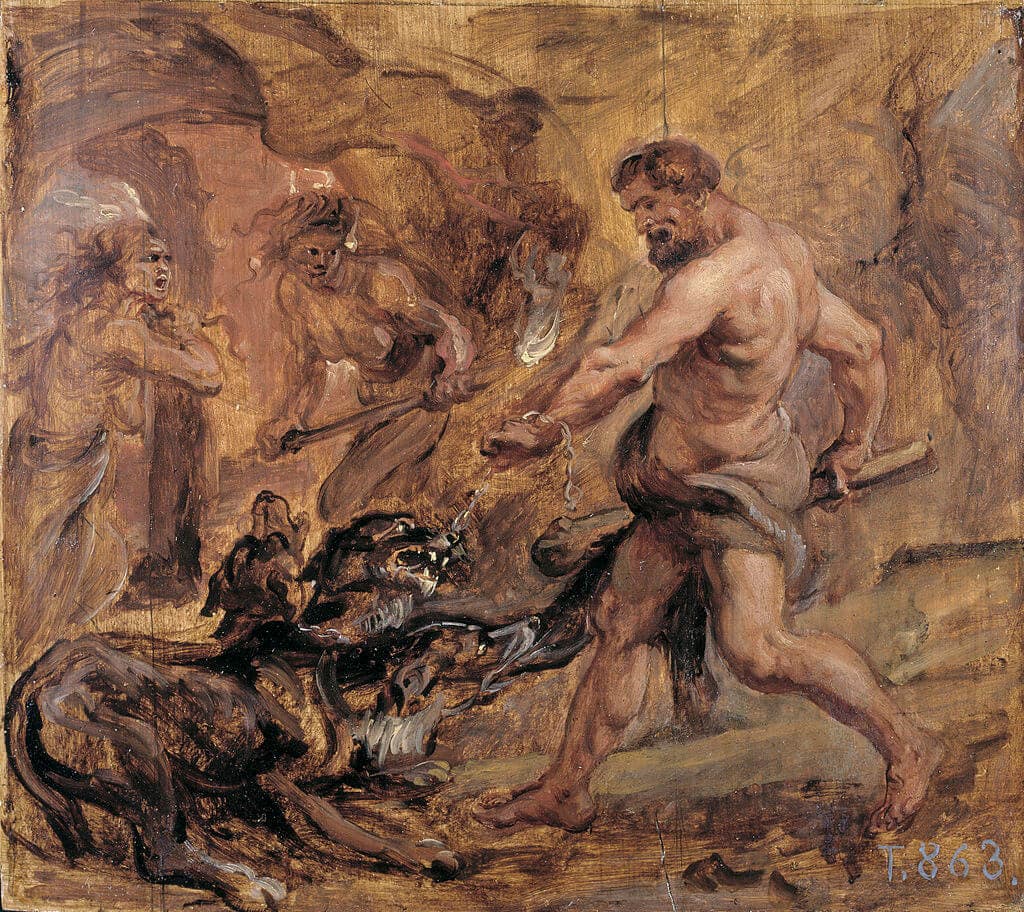
Table of Contents
In Greek mythology, Cerberus was a monstrous three-headed dog that lived in and guarded the Underworld. He was also known as the ‘Hound of Hades’. Cerberus was a terrifying, gigantic creature with a mane of deadly snakes and saliva that could kill with its poison.
Cerberus is mostly known for being captured by the Greek hero, Heracles (Roman: Hercules) as one of his Twelve Labors, a task no one had managed to do before.
Cerberus’ Origins

Cerberus (also spelled as ‘Kerberos’) was the offspring of Echidna and Typhon, two monsters who were half-human and half-snake.
Typhon, like his son, had around 50 to 100 snake heads, which sprang from his neck and hands, while Echidna was known to lure men into her cave and consume them raw. They were horrifying creatures that spread fear and disaster wherever they went and according to some sources, even the Olympian gods were afraid of Cerberus’ monstrous parents.
Typhon and Echidna produced thousands of offspring, many of which were among the most fearsome monsters to have existed in Greek mythology.
Cerberus’ siblings included the Chimera, the Lernaean Hydra and another dog called Orthrus.
Description and Symbolism
There are various descriptions of Cerberus. He was known to have had three heads, but some accounts say he had even more (although this could have been including his mane of snake heads). Having multiple heads was common in Cerberus’ family since his father and many of his siblings were also multi-headed.
Cerberus apart from the three dog heads and many snake heads along his back, the Hound of Hades had the tail of a serpent and lion’s claws. Euripides states that Cerberus had three bodies as well as the three heads, while Virgil mentions that the animal had many backs.
According to various other writers including Hesiod, Euphorion, Horace and Seneca, the animal had fire flashing from his eyes, three tongues and extremely acute hearing.
According to the Greek writer, Ovid, Cerberus saliva was extremely poisonous and was used as an ingredient in poisons made by the sorceress Medea and the Erinyes. When the animal bayed, all farmers who cultivated the land near the realm of Hades would run away, terrified at the sound.
Cerberus’ three heads were thought to symbolize the past, present and future while some sources say they represented birth, youth and old age.
Cerberus Role in Greek Mythology
Although Cerberus was called a ‘hell hound’, he wasn’t known to be evil. As the watchdog of the Underworld, Cerberus’ role was to guard the Gates of Hell, preventing the dead from escaping and protecting it from any unwanted intruders. He was faithful to his master, Hades, the god of the Underworld and served him well.
In addition to guarding the gates, he also patrolled the banks of the River Styx, which formed the boundary between the Underworld and the Earth.
Cerberus also haunted the banks of Acheron, another river that ran through the Underworld, fawning on new, dead spirits as they entered but savagely eating any that tried to go back through the gates into the land of the living without the permission of his master.
Although Cerberus was a fearsome, terrifying monster that guarded the Underworld diligently, there are several myths which tell of Greek heroes and mortals such as Theseus, Orpheus and Pirithous who managed to make it past the hell hound and successfully enter the realm of Hades.
The Twelfth Labor of Hercules
Many of Cerberus’ siblings were famous for having been slain by Greek heroes. Cerberus, however, was best known for his encounter with Hercacles which the beast survived. At the time, Heracles was serving King Eurystheus of Tiryns who had set him twelve impossible labors to complete. The twelfth and final Labor was to bring back Cerberus from the realm of Hades.

Hades Speaks to Persephone
There are several verisons of how Hercules captured the hell hound. The most well known involves Persephone, wife of Hades and the Queen of the Underworld. Instead of taking Cerberus and risking the revenge of the powerful Hades, Heracles spoke to Hades’ wife, Persephone. He told her about the Labor and asked her permission to take Cerberus back with him, promising to return him once the task was complete.
Cerberus is Captured

Persephone spoke to her husband and Hades finally gave Heracles his permission to take Cerberus, on the condition that his hound would not be harmed and would be safely returned to him. Since Heracles wasn’t allowed to harm the Hound of Hades, he wrestled with the beast using nothing but his bare hands. After a long struggle and getting bitten by Cerberus’ serpent tail, Hercules put the beast in a stranglehold and held on until Cerberus finally submitted to his will.
Heracles Takes Cerberus to the Land of the Living
Hercules took Cerberus out of the Underworld and led him to King Eurystheus court. Everyone who saw the beast was overcome with fear, including King Eurystheus who hid in a great jar when he saw it. According to Apollodorus, Hercules then returned the beast to the Underworld but other sources state that Cerberus escaped and returned home on his own.
Other Myths Featuring Cerberus
Other famous myths involving Cerberus are the myths of Orpheus and Aeneas, both of whom tricked Cerberus into letting them pass into the Underworld.
Orpheus and Cerberus
Orpheus lost his beautiful wife Eurydice when she stepped on a poisonous snake and was bitten. Overcome with grief at the death of his beloved wife, Orpheus decided to journey to the realm of Hades to bring back his wife. He played his lyre as he went and all who heard it were enchanted by the beautiful music.
Charon, the ferryman, who ferried only dead souls across the River Styx agreed to carry Orpheus across the River. When Orpheus came upon Cerberus, his music made the monster lay down and fall asleep so that Orpheus was able to pass.
Aeneas and Cerberus
According to Virgil’s Aeneid, the Greek hero Aeneas visited the realm of Hades and encountered the hell hound, Cerberus. Unlike Orpheus who charmed the dog with music and Heracles who battled with the creature, Aeneas had the help of the Greek prophetess, Sibyl. She spiked a honey-cake with sedatives (they were drowsy essences) and tossed it at Cerbus who ate it. Cerberus fell asleep in a few minutes and Aeneas could enter the Underworld.
Cerberus in Art and Literature

Throughout history, Cerberus has been mentioned in ancient literature and works of art. He was a popular theme in Greco-Roman art. The earliest depictions of the beast date back to the start of the sixth century BC, featured on a Laconian cup. In Greece, the capture of Cerberus was often depicted on Attic vases whereas in Rome it was commonly shown together with Hercules’ other Labors as well.
The image of the hell hound became familiar in popular literature and culture in the 20th century. A character similar to Cerberus appears in the film Harry Potter and the Philosopher’s Stone, in which Harry lulls the three-headed dog ‘Fluffy’ to sleep by playing a flute, a scene inspired by the story of Orpheus. Other examples include Arthur Conan Doyle’s Hound of the Baskervilles and Stephen King’s Cujo (the rabit Saint Bernard).
In 1687, astronomer Johannes Hevelius introduced the Cerberus constellation which was depicted as Hercules holding a three-headed snake in his hand. However the constellation is now obsolete.
In Brief
Although there are few narratives about the mythological hell hound, statues and paintings of Cerberus’ myths continued be popular throughout history. Some believe that the Hound of Hades still continues to guard the Underworld, his mournful bray announcing the coming of death.








